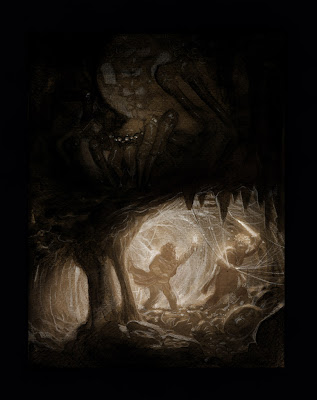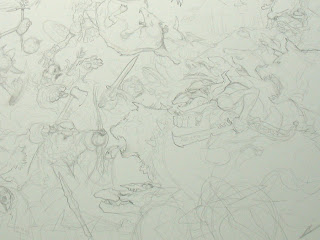
The Battle of Five Armies.
This is for me the quintessential battle of fantasy literature. While it lacks the apocalyptic quality of the battles that take place later in
the Lord of the Rings trilogy, it has within in it a truly wonderful classical feel blended with just enough fantasy to keep it both captivating and believable within the framework of the world. As a child, and even now when I read
the Hobbit, I find myself wanting to see this moment happen when I get to this point in the story. Tolkien hints at it just enough that you find yourself imagining what it would be like to be in a battle between dwarves and goblins. And just when all these things have come together in your mind Tolkien presents this perfect scenario. The perfect fantastic battle. Wolves, Goblins, Goblins riding Wolves, Dwarves, Elves, Bats, Eagles, Men, a mountain of treasure and a gigantic, furious bear.
Tolkien does this same thing later in
the Lord of the Rings, when the fellowship crosses through the Mines of Moria. He suggests the long-standing feud between the dwarves and the goblins. He lets the reader wonder on their own for pages, imagining that goblins are going to come out of any door at any moment. He lets the reader imagine the terror of the situation. Of being trapped underground, in the dark, with creatures that want to kill you. But he also lets you imagine the strategems that might have existed and that the dwarves might have used to defend themselves from the Goblins. The gatehouses, the bridges, the deep chasms. And then he even gives you a brief glimpse into the final moments of the last stand of the dwarves of Moria. And then, when your imagination has already run away with the idea of hordes of angry goblins storming the tunnels and things fouler than orcs in the deep places, he delivers that very thing we have been waiting for. The drums sound in the deep, and the Fellowship has to fight their way out of the same aweful place the Dwarves of Moria were killed in.
Moria is one of my favorite moments in Tolkien's writing and much of that is because it has such a wonderful build up leading up to it.
The Battle of Five Armies is very similar for me. By the time it happens, it has become everything you could hope for. Tolkien is also brilliant for how much of it he leaves to the readers imagination. How much restraint he uses. He sets it up, and then takes Bilbo, our narrator, out of it rather early on. The rest of the events we learn second-hand, and after the event, delivered by Gandalf, who tells it in a straightforward, wholly-understated, British manner. It reads like a Naval report from the Battle of the Nile. Or a battle scene from
Le 'Morte d'Artur. By taking out the narrator early on, and then only telling the most necessary moments of the battle, he lets the reader to fill in the gaps with their imagination. He gives you just enough to go on so that you can imagine the rest of the world on your own.

I would venture that the lack of this sort of restraint was one of the chief reasons the new Star Wars were disappointing to many. In the first trilogy the worlds were only hinted at, and the viewer had to use their imagination for the rest of it. The viewer was given more of an opportunity to take part in the story. The space between the teller and the receiver was bigger and more interesting because more was left to the imagination. But in the new ones, it was more heavily weighted on teller, and less on the receiver, so the space between, the space where imagination is demanded, was diminished. I suspect that this was because in the new ones they could finally fully realize everything. They had the technology, the budget and the ability to show you everything. Now, as opposed to talking in ominous tones about the spice mines of Kessel and letting you imagine the horrors there, they would actually show you. I think that the restraint that the old films had by necessity actually made them more charming and is why they struck such a wonderful chord with everyones imagination in a way that the new ones, visually stunning as they are, don't quite seem to do.
It is mostly because of Tolkien's expert handling of the Battle of Five Armies, that it leaves me with all kinds of moments that I want to depict in this scene. He uses a great deal of restraint in his telling, and I think that makes for better art. But it will be difficult for me to do likewise. My temptation is to do what Lucas did, and to try and fully realize everything without leaving enough to the viewer's imagination. There are so many moments in this part that I want to depict. There are soo many great possibilities. It will be very difficult to pick which moments to include and which ones to leave out.
















































